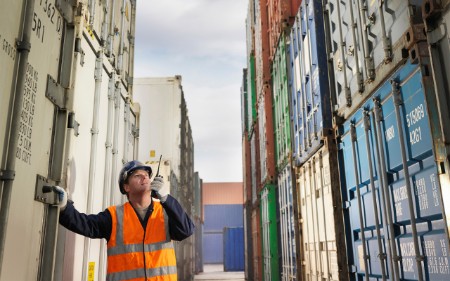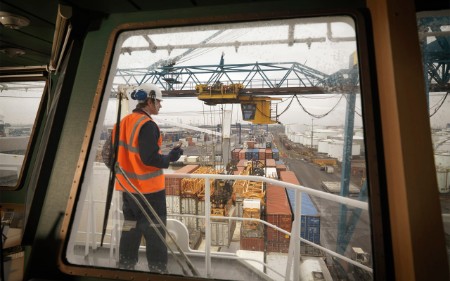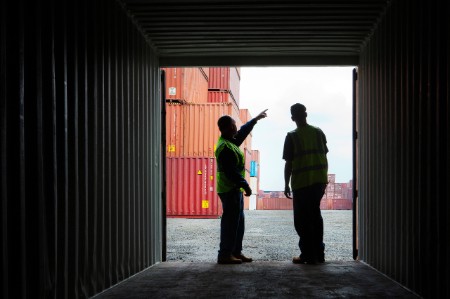
Chapter 1
The benefits of blockchain
Distributed ledgers are inherently harder to attack because, to be successful, a cyber attack would have to attack each copy of the data simultaneously.
Despite its seeming complexity, a blockchain is just another type of database for recording transactions — one that is copied to all of the computers in a participating network. Individual transactions (unique blocks) consist of:
- The header, which includes metadata, such as a unique block reference number, the time the block was created and a link back to the previous block
- The content, which is usually a validated list of digital assets and instruction statements, such as transactions made, their amounts and the addresses of the parties to those transactions
In this type of secure, shared database, participants have their own copies of the stored data. Strong cryptography ensures that transactions can be initiated only by certified parties, that changes are validated by participants collectively and that the outputs of the system are immediate, accurate and irrevocable.
Distributed ledgers are inherently harder to attack because, to be successful, a cyber attack would have to attack each copy of the data simultaneously.
A complete audit trail is maintained throughout the chain by the distributed nature of the information. Anyone with the appropriate encryption rights can access a copy of that ledger and verify past transactions without having to trust the participants in the original transaction.
A blockchain database, then, is a digital ledger that retains the complete history of all assets and instructions executed since the very first one — making its data verifiable and independently auditable.
The great trust that participants and auditors can have in a blockchain depends on this process, not on the reputation or reliability of one participant such as a bank.
Smart contracts
One application of blockchain that promises to transform business is smart contracts — computer programs that facilitate, verify or enforce the negotiation or execution of an agreement. They often replicate the logic of regular contractual clauses. Through smart contracts, many types of contractual clauses can be made partially or fully self-executing, self-enforcing or both.
Consider the example of a container-load of goods whose legal ownership is transferred while the goods are in transit. Whether value-added tax (VAT) or goods and services tax (GST) applies, which jurisdiction levies it and at what rate, and who must account for it are all questions whose answers may depend on where the goods were physically located when the transfer of ownership took place.
This could be the case even if neither party was alert to the importance of timing or the location of the transfer. This issue commonly arises in chain transactions, for example, involving oil and other commodities, where ownership in the goods may change many times between dispatch and arrival. Smart contracts could help solve this perennial time-of-supply problem, particularly for cross-border trades.
And to take the automation process one step further, “smart” products and devices can be used. These have the ability to communicate with one another, and to report their status and position using the internet. This allows them to confirm when certain conditions in a contract have been met, so triggering payment and the creation of the next block.
Such blockchain-enabled smart contracts, concluded by “things” communicating with other “things,” will create many challenges and opportunities for businesses — and for tax and customs administrations.

Chapter 2
Blockchain’s near-term potential for indirect tax
We explore some of the likely near-term uses of blockchain that could have an impact on indirect taxes.
For tax advisors, the definition of a blockchain often brings to mind indirect taxes. These taxes include broad-based taxes on consumption such as VAT, GST and sales taxes, but also customs duties, excise taxes energy taxes and environmental levies.
These taxes often follow chains of transactions and their tax liabilities, and obligations are often “triggered” by key events that need to be documented and recorded securely. These events include the performance of a service or the delivery of goods, the conclusion of a contract, the manufacture of a product and by an act of importing or exporting goods and services.
How, where, when and what tax applies often depends on complex decisions that must be applied correctly for every transaction. Collecting the right amount of tax depends on the honest reporting of accurate information, often in “real time.” Taxpayer errors, negligent accounting, lack of data and fraudulent activity can all have a significant impact.
We are starting to see tax administrations around the world considering blockchain technology. Surely, it is only a matter of time before applications become a reality.
Increasingly, blockchains will find new applications where they are coupled with artificial intelligence, robotic process automation, machine learning and the Internet of Things. So what are some of the likely near-term uses of blockchain that could have an impact on indirect taxes?
Blockchain regimes
VAT and customs administrations could create blockchains for the transmission of tax data and payments between taxpayers and government portals. These blockchains could involve taxpayers in a single jurisdiction or they could cross multiple jurisdictions, such as within the European Union or Gulf Cooperation Council.
Blockchains will find new applications where they are coupled with artificial intelligence, robotic process automation, machine learning and the Internet of Things.
Real-time compliance and reporting
Tax administrations around the globe are already demanding real-time information from businesses in order to assess and support their VAT and GST liabilities and deductions. Blockchains could greatly increase the speed, accuracy and ease of collecting this data, thereby improving the quality of VAT and GST compliance while reducing the cost of enforcement.
Tax invoices
The invoice is the most critical VAT document. In a blockchain-based regime, it is likely that for a VAT invoice to be valid, it will require a digital fingerprint, derived through the VAT blockchain consensus process.
The fingerprint would immediately confirm that the block under scrutiny is permanently linked to the previous and subsequent blocks. The entire history of the commercial chain (forward and backward from this transaction) could be followed and scrutinized by a tax official in an office, by a robot or by a customs officer at a border.
Anyone connected to an approved tax-auditing program could immediately pull up the entire commercial chain for an item from a valid invoice.
Customs documentation
Customs declarations and export controls depend on detailed, accurate information to prove the origin and destination of goods, their end use, and their composition or classification, not only to ensure the correct payment of duties but also to satisfy regulations that forbid trade in illegal or dangerous substances.
The veracity and reliability of this information is vital, but certainty can be difficult to achieve as the necessary details are often provided by third parties, and they may be extracted from a range of systems within an organization. Errors can lead to penalties, lost opportunities and costly delays in transferring goods across borders.
Often it is difficult for traders and customs brokers to provide sufficient information or documentary proof to benefit from any potential reliefs or reductions (such as those available through a free trade agreement, for example). However, if the items were traded in a blockchain and the customs authorities had access to the chain, they could verify with complete accuracy the origin and nature of the goods at every stage of the chain.
This would not only apply to finished products but also to raw materials, components and semi-finished goods. Customs authorities could, for example, collect duties automatically as goods transit across borders, cutting out third-party declarations. And as this technology would allow them to verify every aspect of a shipment with certainty, they could maintain supply chain security with fewer officers who could target their inspections more accurately.
Supporting refunds, reliefs and rebates — and combatting fraud
The use of immediately verifiable information could allow taxpayers to support claims for VAT and GST deductions and customs rebates and reliefs.
Fraudulent and incorrect claims for input tax deductions pose a severe threat to many VAT and GST systems. Currently, a VAT payer who has a valid tax invoice or customs declaration (or what appears to be a valid document) is entitled to offset the VAT shown on the document as input tax against VAT charged on sales (output tax) or to claim a refund if there is no output tax to offset.
This applies even if the supplier has not paid the tax due. A valid VAT invoice serves like a check on the tax office, and the tax administration may permanently be out of pocket if the document used to claim the input tax is false or if the supplier who has issued it acts in bad faith and does not pay the output tax shown.
The most familiar scam in the European Union is the Missing Intra-Community Trader fraud, but that is just one manifestation of the danger that dishonest traders can pose to an entire system: VAT revenue lost through fraud in the EU is estimated at EUR 100 billion per year. Customs fraud also takes its toll as, for example, shippers mask the true origin of goods to qualify for preferential import duties or free trade agreements.
Tax and customs administrations combat fraud by demanding high levels of accuracy for accounting and reporting to support indirect tax filings and customs declarations. However, these demands can create significant compliance obligations for taxpayers and cross-border traders.
The speed, accuracy and transparency of blockchains could help to alleviate these burdens for taxpayers by decreasing the risk of fraud. Where blockchains can allow sensitive or valuable data to be passed with accuracy and trust, it is not surprising that they are becoming more commonly embedded in day-to-day business processes. Governments and regulators are already looking to them to solve some common issues created by poor recordkeeping or that require high levels of proof such as identifying land ownership rights.
We’ve seen how clever criminals can be, so we can’t assume blockchain will eliminate fraud, but using a blockchain to collect and offset tax could greatly reduce this risk. The output tax on a transaction could be taken by the tax administration when the transaction took place, and the right to offset input tax could be verified immediately but only once the tax was paid.
Smart audits
Using blockchain regimes, indirect tax administrations could carry out independent risk analysis facilitated by artificial intelligence. Because the indirect tax blockchain regime would probably be linked to other government sources, the auditors could have immediate access to large numbers of public and private databases and large amounts of taxpayer and comparative data.
Statistical anomalies could be identified in real time, and the relevant authorities (including those in other countries) could be alerted.

Chapter 3
Five ways to prepare for the future of blockchain
One day using blockchain technology will be common. Businesses can prepare now by taking the following steps.
As computing power and connectivity increase exponentially, the applications for blockchain are likely to multiply, and costs will fall. This will allow many blockchain applications to go from being a good idea for the future to becoming a practical daily reality.
And while these applications may not yet be available in the world of indirect tax, it seems likely that one day using blockchain technology will be common — even mandatory — for accounting for and the collection of indirect taxes.
Businesses can prepare now by taking the following steps.
- Assess the capability of your leadership team. Your leaders’ ability to facilitate digital innovation is critical. A leadership coach skilled in digital leadership evaluation can assist you.
- Add blockchain to the learning agenda. Your indirect tax professionals need to be able to talk knowledgeably about blockchain, and your tax technology and IT teams need to know the technical details. You should also quiz your tax advisors about their readiness.
- Educate your board. Indirect tax compliance deadlines are becoming tighter, and this may accelerate the adoption of blockchain solutions. The C-suite needs to realize that traditional roles, structures and processes may not be sufficient for the new technological nature of indirect tax compliance.
- Collaborate with thought leaders. Innovation is not always best done alone — consider working with academic institutions, professional associations, and public and private sector partnerships that employ a creative and consultative approach to delivering solutions.
- Recruit ‘blockchainers.’ Often the quickest way to gain knowledge and experience is to hire it. Bitcoin entrepreneurs, steeped in the technology and its applications, may more readily see the opportunities that blockchain adoption could provide for your organization.
Resumen
As computing power and connectivity increase, blockchain applications for tax will go from being a good idea to becoming a daily reality.


